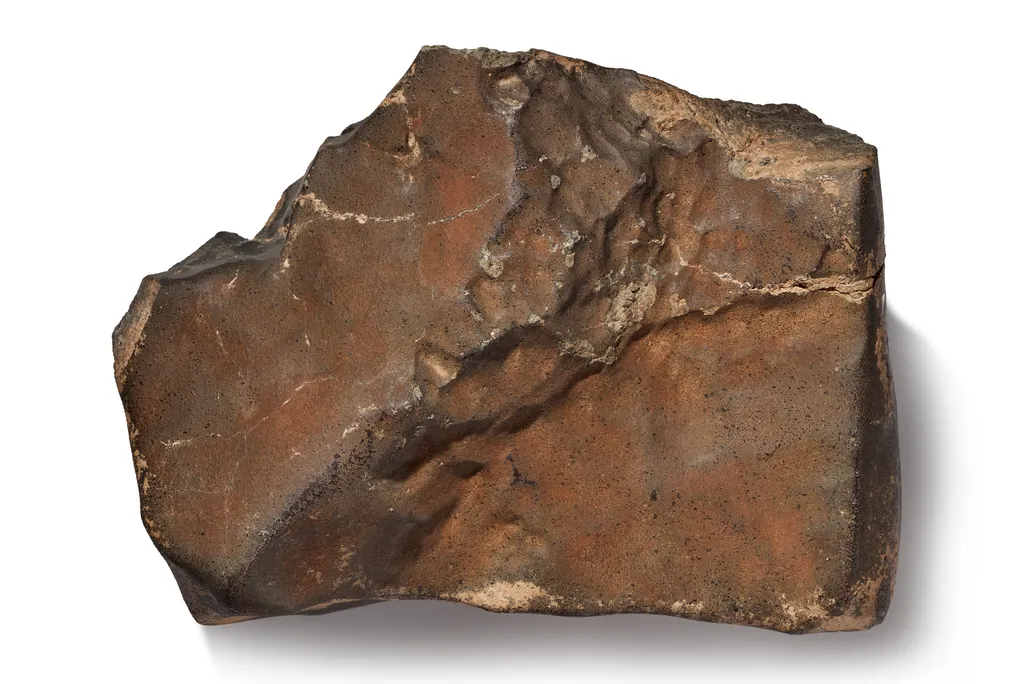The Largest Martian Meteorite in the World Is Heading to Auction and Could Sell for $4 Million
Discovered in Niger in 2023, the rare chunk weighs 54 pounds and represents more than 6 percent of all Mars material on Earth

Humans are still dreaming about landing on Mars. But periodically, chunks of the Red Planet come crashing down on Earth.
Now, one of those rare Mars rocks is heading to auction. The largest Martian meteorite ever found on Earth, called NWA 16788, could sell for as much as $4 million at Sotheby’s natural history sale in New York on July 16.
Meteorites are pieces of space debris that survived the journey through Earth’s atmosphere to reach the surface. When these objects are still hurtling through space, they’re known as meteoroids. And as they’re traveling through Earth’s atmosphere, they’re called meteors (or, colloquially, shooting stars).
An anonymous meteorite hunter discovered NWA 16788 in the Kefkaf region of Niger on July 16, 2023, according to the Lunar and Planetary Institute. (NWA stands for “Northwest Africa.”) A fragment of the grayish-brown rock was later sent to the Shanghai Astronomy Museum for analysis.
The chunk weighs more than 54 pounds, which makes it about 70 percent bigger than the next-largest known Mars meteorite, according to Sotheby’s. NWA 16788 is so large that it represents more than 6 percent of all Martian material ever found on Earth.
/https://tf-cmsv2-smithsonianmag-media.s3.amazonaws.com/filer_public/c5/27/c527f88e-4b75-458f-9358-88122831694d/nwa_16788_courtesy_of_sothebys_2.jpg)
NWA 16788 is also rare. It’s one of roughly 400 known meteorites from Mars, which together make up a small fraction of the more than 77,000 officially recognized meteorites from all extraterrestrial sources, per Sotheby’s.
“That chunk had to be loose enough to break off, and then it had to get on the right trajectory to travel 140 million miles to Earth, and then it had to land in a spot where someone could find it,” says Cassandra Hatton, vice chairman of science and natural history for Sotheby’s, to Gothamist’s Ryan Kailath. “And then we were lucky enough that someone came by who knew enough about meteorites to recognize that it wasn’t just a big rock.”
Did you know? When a meteorite hit a doghouse
In 2022, a doghouse that had been hit by a meteorite years earlier sold for $44,000 at an online Christie’s auction. The space rock narrowly missed the house’s resident—a German shepherd named Roky—when it crashed through the roof on April 23, 2019, in Aguas Zarcas, Costa Rica.
The object is what’s known as a “shergottite meteorite,” which is the most common type of meteorite from Mars. Scientists believe these fragments, which are named after the Shergotty meteorite that fell in India in 1865, come from the Red Planet’s volcanic regions.
Based on its internal composition, scientists think NWA 16788 was torpedoed from the Martian surface by an asteroid impact. The collision was so powerful that it transformed roughly 20 percent of NWA 16788’s minerals into a type of glass known as maskelynite. Parts of its surface are also covered in a glassy fusion crust, which likely formed as it careened through Earth’s atmosphere, generating high temperatures.
It’s not clear exactly when NWA 16788 landed on Earth. However, based on the lack of visible weathering, it probably fell somewhat recently, according to Sotheby’s.
/https://tf-cmsv2-smithsonianmag-media.s3.amazonaws.com/filer_public/f9/78/f97811af-1b87-48ba-b5ad-bc741e1562a6/nwa_16788_-_courtesy_of_sothebys_3.jpg)
In a statement, Hatton describes the meteorite as a “once-in-a-generation find” that provides a link to “our celestial neighbor that has long captured the human imagination.”
Some onlookers, however, are disappointed that NWA 16788 is being sold to the highest bidder, rather than being donated to a scientific institution or museum.
“It would be a shame if it disappeared into the vault of an oligarch,” says Steve Brusatte, a paleontologist at the University of Edinburgh in Scotland, to CNN’s Jack Guy.
However, other experts are less concerned about the sale. A fragment of the rock has already been analyzed, and a reference sample is being kept at the Purple Mountain Observatory in China, per CNN. In addition, the new owner may ultimately choose to donate the specimen or support future research on it.
“Meteorites are unique specimens that carry information about the history of the solar system that cannot be learned any other way,” Paul Asimow, a geologist at the California Institute of Technology, says in an email to Artnet’s Richard Whiddington. “This is mitigated by the scale at which we can study meteorites, and a sub-sample is likely to contain all the information that the whole stone contains.”
In addition to the Martian meteorite, Sotheby’s is also auctioning off other rare items. The offerings include a Late Neolithic stone axe, the skeleton of a 150-million-year-old juvenile Ceratosaurus dinosaur, an articulated Tyrannosaurus rex foot and other fossils.
/https://tf-cmsv2-smithsonianmag-media.s3.amazonaws.com/accounts/headshot/SarahKuta.png)
